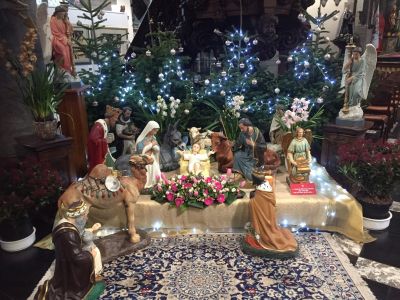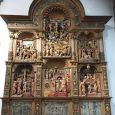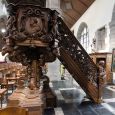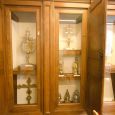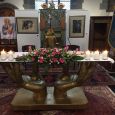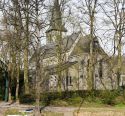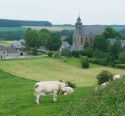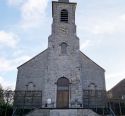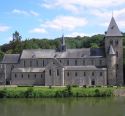Church | XII-XV & XVIII | Neogothic | Catholic Church

Map
Opening hours
01 January - 31 December
Mon
Tue
Wed
Thu
Fri
Sat
Sun
Only on request:
paroissedebouvignes@gmail.com +32 477 98 00 75 (Frère Jean-Baptiste)
or Maison du Patrimoine médiéval mosan: +32 82 22 36 16
Guided tour
Free and on request:
via the Maison du Patrimoine médiéval mosan
(open all year round except Mondays)
www.mpmm.be - info@mpmm.be +32 82 22 36 16
Religious offices
Sundays and public holidays: 10.30 am
More information on the parish website:
www.paroissedebouvignes.com
Description
Bouvignes is located on the Meuse opposite Dinant and one has the feeling that time has stopped here. The town was once known for its copper beaters and was prosperous. Traces of this are still visible today with the remains of the count’s ancient castle and the keep of Crèvecoeur which dominates the village.
Amongst the old blue stone or timbered houses, of which the old Spanish or so called bailiff’s house is one, stands the imposing church with its powerful square tower. The building dates from the 12th century. Over the centuries it has been subjected to a number of destructions, transformations and renovations. After the damage caused by the 1914-1918 war early Gothic style was emphasised.
Inside is a very beautiful altarpiece of the true cross created in 16th century Antwerp, a 15th century Christ Pieta and a pulpit.
For a year now, the church has kept a very beautiful invitation to prayer: more than a hundred holy images or icons from Russia and Greece from the 16th to the 21st century.
Photos
Media
Remarkable elements
Scaldic Passion Altarpiece
The Saint-Lambert Church in Bouvignes houses a rare Antwerp altarpiece from the mid-16th century, preserved in the south aisle of the building. This Passion altarpiece, crafted by the cabinetmaker Jean Leuthard, is made of carved and polychrome oak, measuring 3.50 meters in height, 2.57 meters in width, and 0.35 meters in depth. It consists of a predella and a main section with six niches illustrating scenes from the Passion of Christ. It is known as the "Altarpiece of the Passion" or the "Altarpiece of the True Cross."
The work, created shortly after the Sack of Antwerp in 1554, was donated to the church by Jean Patenier and Jeanne Bouille. Restored in the early 1990s with the help of the King Baudouin Foundation and the National Lottery, the altarpiece had lost several of its sculpted and painted elements over time. In 2015, a painted panel from the predella was rediscovered and returned to the church in 2016. This altarpiece was recognized as "Exceptional Heritage of Wallonia" in March 2010.
Christ of Pity
This oak sculpture of the Christ of Pity, dating from the first half of the 16th century and measuring 178 cm in height, depicts Christ crowned with thorns, dressed in a loincloth, seated on a rock, and weeping as He awaits the crucifixion. The sculpture is notable for the contrast between its slender upper part and its massive lower part, symbolizing the spirit rising towards God and the body awaiting crucifixion. The twist of the torso, the tilt of the head to the left, and the position of the right leg suggest movement.
Likely originating from a Brabantine workshop, this work commemorates the end of the church’s restoration following the 15th-century wars with the Liégeois. Moved to the cemetery in 1639 and protected by a lean-to, it was brought back to the church in the early 19th century. The sculpture was partially restored in the 1920s by the Royal Institute for Cultural Heritage (IRPA).
Floreffe Pulpit
The Floreffe pulpit, dating from the 17th century and attributed to the Valenciennes sculptor Pierre Schleiff, was purchased by the town's magistrates on May 9, 1770, from the Norbertine Abbey of Floreffe for the church of Bouvignes. This oak pulpit features various decorative elements: busts of Saints Paul and Peter at the base of the staircase, intertwined cherubs among vines on the handrail, and the symbols of the four evangelists (eagle, child, lion, ox) at the corners of the pulpit. Medallions surrounding the pulpit depict the Virgin, Saint Augustine, Saint John, and Saint Norbert. Initially topped with a sounding board from the Augustinian chapel of Bouvignes, now lost, the dove that once adorned it is now attached to the crossing of the choir’s vaults.
Eagle- lectern
The eagle-lectern, dating from the early 17th century and made of a copper alloy, stands 150 cm tall. This lectern, used to support the Gospel book, is decorated with an eagle symbolizing the sky, the soul, and the Holy Spirit. The eagle, known for its power and victory, is associated with Saint John the Evangelist and often holds a globe representing universal sovereignty. Such lecterns were common in Europe during the Middle Ages.
The lectern in Bouvignes, with its head bent towards its chest, is sometimes referred to as a pelican-lectern, symbolizing charity and the sacrifice of Christ. This type of lectern became widespread in the 16th and 17th centuries. A light fixture was attached to the bird’s head. The work is attributed to the coppersmith Antoine de Nassogne († 1621).
Funerary blade
About 1629, copper-based alloy, h. 116 cm.
It was made for Antoine de Nassogne, who died in 1621, alderman and copper beater, and his wife Marguerite le Bidart, who died in 1629. It is decorated with the Nassogne-Bidart coat of arms. It shows a wild man armed with a club carried on his shoulder and surmounting a helmet in profile, coats of arms, a small cauldron and a winged angel's head.
The blade used to be in the choir of the church. It was broken by a falling bell and restored shortly before 1888.
The treasure room (winter chapel)
At the instigation of the church's Fabrique, this space was converted into a winter chapel in 2008 to accommodate the faithful during Sunday services. It houses the church treasury, including numerous pieces of liturgical silverware. Exceptionally, the church has kept practically all the chalices of its servants since the end of the 17th century.
The new high altar
Glass table supported by two hands representing those of Christ, copper-based alloy (2004). Work of the artists Simon Lewi (1924-2020) and Piotr Stolowsky.
Similar altars are preserved in the church of Sainte-Croix de La Futaie in Watermael-Boitsfort, Saint-Joseph in Wezembeek-Oppem, Saint-Antoine de Padoue in Etterbeek and Saint Michael's Cathedral in Brussels.
In Bouvignes, the artist also made the cathedra of the Saint-Lambert church (seat where the priest who presides over religious services sits).
Nearby
Circuit
The old stones and their treasures

Detours and other pilgrimages in Namur (loop 4) - The time machine does not yet exist. Maybe one day... In the meantime, if you want to go back a few centuries, a short walk through Bouvignes and Dinant is a must.













